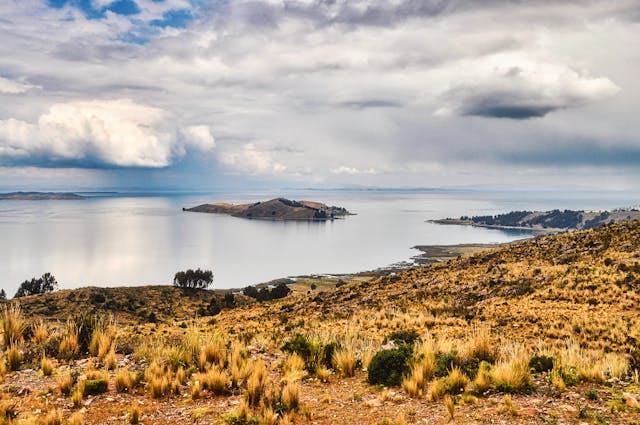
Why is Lake Titicaca so high up? It was formed in a hollow in the mountain and is replenished by melting glaciers.
Lake Titicaca is located in the Andes mountains, on the border of Bolivia and Peru. Its surface is 3,812 m above sea level. It if often thought to be the highest lake in the world, but it is actually only the highest navigable lake in the world. That means big ships can sail along it, which is made possible by its size. The lake has a surface area of 8,327 km2, which makes it the 18th largest lake in the world. Ojos del Salado is actually the highest lake in the world and it is 6,879 m above sea level, although it only has a surface area of about 10 km2. Ojos del Salado has formed inside a dormant volcano.
It is fairly rare to find a lake on top of a mountain because the water usually drains downhill faster than it can be replenished. On the top of a mountain, the only real source of water would be from rainfall. However, Lake Titicaca is not on the top of a mountain, it is high up in a mountain range and there are many other taller mountains that surround it. Rain runoff from these mountains and meltwater from glaciers is what fills Lake Titicaca. The lake is fed by five different rivers and only one river runs out of it. The river that flows out removes about 5% of the lake’s volume, which is replaced by incoming water. Unfortunately, recently, the amount of water in Lake Titicaca is declining and the shoreline has receded by about 80 m. This is due to changing rainfall patterns and the receding glaciers in the Andes, both of which are worsened by climate change and the current El Nino. There is an ongoing drought in the area as well. Some of the water is lost by outflow, but the majority is lost to evaporation. There are very strong winds that high up in the mountains and very strong sunlight, both of which speed up the evaporation of the lake. If it is not being replenished as quickly as it evaporates, it will shrink. Hopefully, the water level will rebound when the drought, but the fact that there is less rain and the glaciers are disappearing is not a problem that will fix itself.
So, why is Lake Titicaca so high up? The lake formed about 60 million years ago and it formed in a bowl made by the movements of tectonic plates. First, the Andes mountains were pushed up and the high plain that Lake Titicaca is on was formed. Then, the space the lake fills was hollowed out. The bowl that Lake Titicaca formed in is known as a pull-apart basin. A pull-apart basin is basically explained in its name. When two tectonic plates pull apart, or shift horizontally, the land between them has no support and sinks, creating a basin. The Dead Sea has formed in a pull-apart basin. It doesn’t always follow that a lake will form, but if there is enough incoming water into the basin, it is likely. The Andes mountains were pushed up, and then the plates moved, creating the pull-apart basin at high altitude.
Lake Titicaca is the highest navigable lake because large ships can function on it, but the only way to get those ships to the lake is to build them on site. There is no way the ships can be sailed to the lake because the one river that goes out of it is too steep. All of the large vessels that sail on the lake were built elsewhere, transported to the lake in pieces, and then assembled. There are also still several steamships that work on the lake. All of these were built in the UK and shipped in pieces to the lake.
Another interesting thing about Lake Titicaca is that it has several manmade islands across it. It was a very important site for the Incas and there are several shrines and Inca ruins there as well. The manmade islands were constructed by the Uru people, and they are still there today. The Uru people are found nowhere other than on these islands and they see themselves as the owners of the lake. The islands are made from the thick bulrushes that grow on the shore of the lake. They dry the bulrushes out, and use them to build the islands. They start with a layer of bulrushes tied together in pallets as a foundation and then they add more and more layers of reeds on top until they have an island. They constantly add bulrushes on top to strengthen the island and they construct houses as well. The islands last for about 25 years before they become too waterlogged and sink. When that happens, the Uru people just make a new island. And this is what I learned today.
Photo by Viajante Dibujero: https://www.pexels.com/photo/lake-titicaca-in-bolivia-4856070/
Sources
https://www.valenciatravelcusco.com/passion-passport/interesting-facts-about-lake-titicaca
https://en.wikipedia.org/wiki/Lake_Titicaca
https://en.wikipedia.org/wiki/Uru_people
https://www.iflscience.com/the-worlds-highest-lake-isnt-lake-titicaca-69765
https://en.wikipedia.org/wiki/Ojos_del_Salado
https://en.wikipedia.org/wiki/List_of_lakes_by_area
